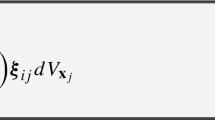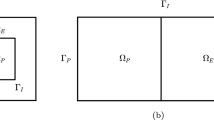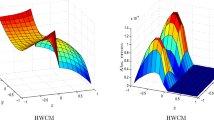Abstract
The immersed boundary method is an effective technique for modeling and simulating fluid-structure interactions especially in the area of biomechanics. The effect of the regularized delta function on the accuracy is an important subject in the property study. A method of manufactured solutions is used in the research. The computational code is first verified to be mistake-free by using smooth manufactured solutions. Then, a jump in the manufactured solution for pressure is introduced to study the accuracy of the immersed boundary method. Four kinds of regularized delta functions are used to test the effect on the accuracy analysis. By analyzing the discretization errors, the accuracy of the immersed boundary method is proved to be first-order. The results show that the regularized delta function cannot improve the accuracy, but it can change the discretization errors in the entire computational domain.
Similar content being viewed by others
References
Peskin, C. S. Numerical analysis of blood flow in the heart. J. Comput. Phys., 25, 220–252 (1997)
Peskin, C. S. and McQueen, D. M. A three-dimensional computational method for blood flow in the heart I. immersed elastic fibers in a viscous incompressible fluid. J. Comput. Phys., 81, 372–405 (1989)
Dillion, R., Fauci, L. J., and Gaver, D. A microscale model of bacteria swimming, chemotaxis, and substrate transport. J. Theor. Biol., 177, 325–340 (1995)
Fauci, L. J. and McDonald, A. Sperm motility in the presence of boundaries. B. Math. Biol., 57, 679–699 (1995)
Fauci, L. J. and Peskin, C. S. A computational model of aquatic animal locomotion. J. Comput. Phys., 77, 85–108 (1988)
Bottino, D. C. Modeling viscoelastic networks and cell deformation in the context of the immersed boundary method. J. Comput. Phys., 147, 86–113 (1998)
Fogelson, A. L. Continumm models of platelet aggregation: formulation and mechanical properties. SIAM J. Appl. Math., 52, 1089–1110 (1992)
Fauci, L. J. and Fogelson, A. L. Truncated Newton’s methods and the modeling of complex immersed elastic structures. Comm. Pure Appl. Math., 46, 787–818 (1993)
Eggleton, C. D. and Popel, A. S. Large deformation of red blood cell ghosts in a simple shear flow. Phys. Fluids, 10, 1834–1845 (1998)
Tu, C. and Peskin, C. S. Stability and instability in the computation of flows with moving immersed boundaries: a comparison of three methods. SIAM J. Sci. Stat. Comput., 13(6), 1361–1376 (1992)
Stockie, J. M. and Wetton, B. R. Analysis of stiffness in the immersed boundary method and implications for time-stepping schemes. J. Comput. Phys., 154, 41–64 (1999)
Stockie, J. M. and Wetton, B. R. Stability analysis for the immersed fiber problem. SIAM J. Appl. Math., 55, 1577–1591 (1995)
Gong, Z. X., Huang, H. X., and Lu, C. J. Stability analysis of the immersed boundary method for a two-dimensional membrane with bending rigidity. Commun. Comput. Phys., 3(3), 704–723 (2008)
Beyer, R. P. and LeVeque, R. J. Analysis of a one-dimensional model for the immersed boundary method. SIAM J. Numer. Anal., 29, 332–364 (1992)
Griffith, B. E. and Peskin, C. S. On the order of accuracy of the immersed boundary method: higher order convergence rates for sufficiently smooth problems. J. Comput. Phys., 208, 75–105 (2005)
Lai, M. C. and Peskin, C. S. An immersed boundary method with formal second-order accuracy and reduced numerical viscosity. J. Comput. Phys., 160, 705–719 (2000)
Gong, Z. X., Lu, C. J., and Huang, H. X. Accuracy analysis of immersed boundary method using method of manufactured solutions. Appl. Math. Mech. -Engl. Ed., 31(10), 1197–1208 (2010) DOI 10.1007/s10483-010-1353-x
Lai, M. C. Simulations of the Flow Past an Array of Circular Cylinders as a Test of the Immersed Boundary Method, Ph. D. dissertation, New York University (1998)
Steinberg, S. and Roache, P. J. Symbolic manipulation and computation fluid dynamics. J. Comput. Phys., 57, 251–284 (1985)
Roache, P. J. Verification and Validation in Computational Science and Engineering, Hermosa Publishers, Albuquerque (1998)
Roache, P. J. Code verification by the method of manufactured solutions. J. Fluid Eng., 124(1), 4–10 (2002)
Oberkampf, W. L. and Trucano, T. G. Validation Methodology in Computational Fluid Dynamics, American Institute of Aeronautics and Astronautics, Denver, 2000–2549 (2000)
Oberkampf, W. L. and Trucano, T. G. Verification and validation in computational fluid dynamics. Prog. Aero. Sci., 38, 209–272 (2002)
Roy, C. J., Nelson, C. C., Smith, T. M., and Ober, C. C. Verification of Euler/Navier-Stokes codes using the method of manufactured solutions. Int. J. Numer. Mech. Fl., 44, 599–620 (2004)
Bond, R. B., Ober, C. C., and Knupp, P. M. A manufactured solution for verifying CFD boundary conditions, part III. 36th AIAA Fluid Dynamics Conference, American Institute of Aeronautics and Astronautics, San Francisco, 1966–1982 (2006)
Brunner, T. A. Development of a grey nonlinear thermal radiation diffusion verification problem. Transactions of the American Nuclear Society, 95, 876–878 (2006)
Eca, L., Hoekstra, M., Hay, A., and Pelletier, D. On the construction of manufactured solutions for one- and two-equation eddy-viscosity models. Int. J. Numer. Mech. Fl., 54, 119–154 (2007)
Tremblay, D., Etienne, S., and Pelletier, D. Code verification and the method of manufactured solutions for fluid-structure interaction problems. 36th AIAA Fluid Dynamics Conference, American Institute of Aeronautics and Astronautics, San Francisco, 882–892 (2006)
Peskin, C. S. The immersed boundary method. Acta Numer., 11, 1–39 (2002)
Stockie, J. M. Analysis and Computation of Immersed Boundaries with Application to Pulp Fibers, Ph. D. dissertation, University of British Columbia (1997)
Author information
Authors and Affiliations
Corresponding author
Additional information
Project supported by the National Natural Science Foundation of China (No. 11102108) and the Shanghai Leading Academic Discipline Project (No. B206)
Rights and permissions
About this article
Cite this article
Gong, Zx., Lu, Cj. & Huang, Hx. Effect of regularized delta function on accuracy of immersed boundary method. Appl. Math. Mech.-Engl. Ed. 33, 1453–1466 (2012). https://doi.org/10.1007/s10483-012-1635-9
Received:
Revised:
Published:
Issue Date:
DOI: https://doi.org/10.1007/s10483-012-1635-9




